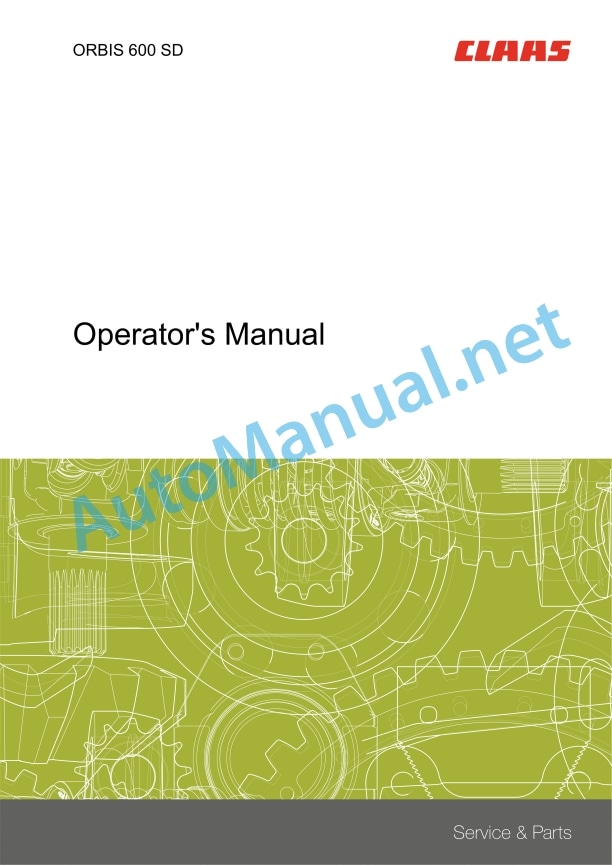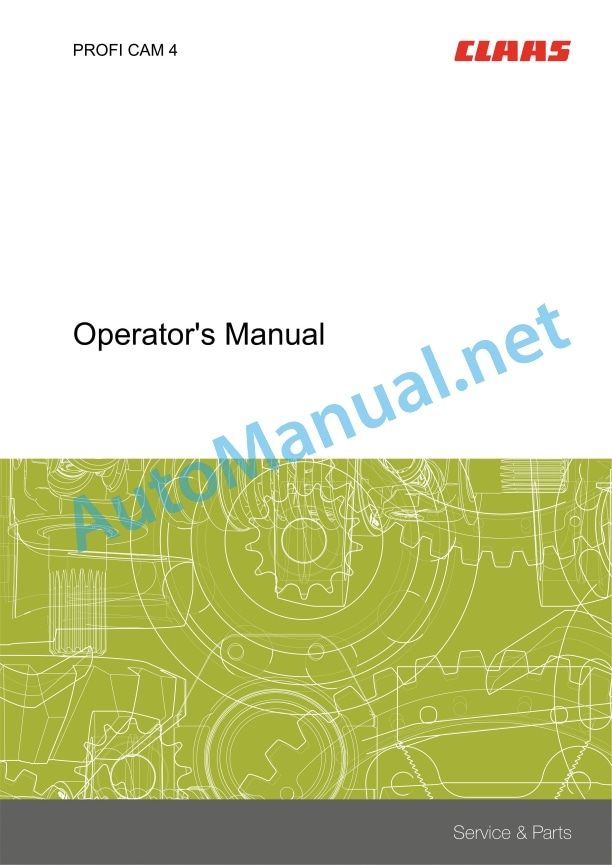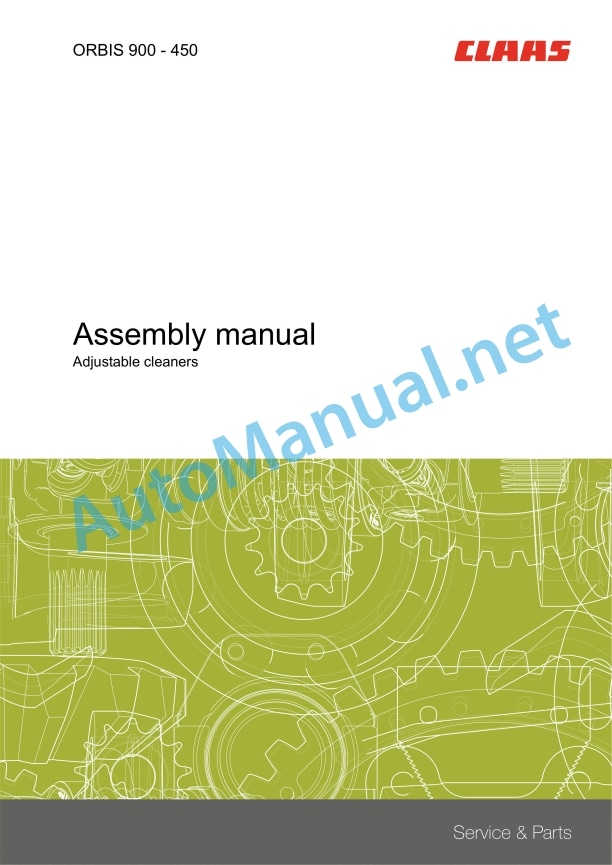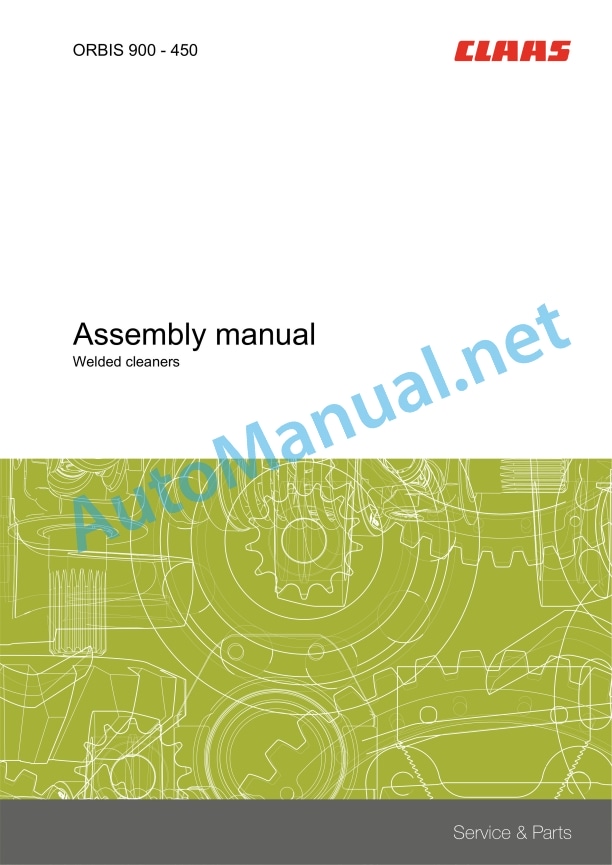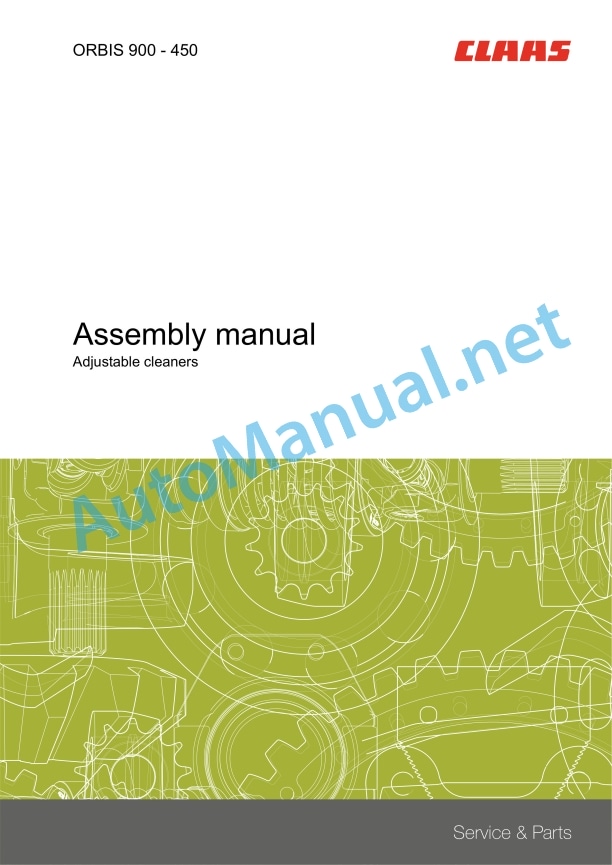Claas Orbis 600 Sd (I51) Forage Harvesters Operator Manual EN
$50.00
- Model: Orbis 600 Sd (I51) Forage Harvesters
- Type Of Manual: Operator Manual
- Language: EN
- Format: PDF(s)
- Size: 71.2 MB
File List:
00 0292 851 4.pdf
00 0301 051 0.pdf
00 0303 482 0.pdf
00 2601 384 3.pdf
00 2702 465 0.pdf
00 2716 134 0.pdf
00 0292 851 4.pdf:
ORBIS 600 SD
Table of contents
1 Introduction
1.1 General information
1.1.1 Validity of the manual
1.1.2 Information about this Operator’s Manual
1.1.3 Symbols and notes
1.1.4 Optional equipment
1.1.5 Qualified specialist workshop
1.1.6 Notes on maintenance
1.1.7 Notes on warranty
1.1.8 Spare parts and technical questions
1.2 Intended use
1.2.1 Intended use
1.2.2 Reasonably foreseeable misuse
2 Safety
2.1 Identifying warnings
2.1.1 Hazard signs
2.1.2 Signal word
2.2 Safety rules
2.2.1 Meaning of Operator’s Manual
2.2.2 Observing safety decals and warnings
2.2.3 Requirements for all persons working with the machine
2.2.4 Children in danger
2.2.5 Hazard areas
2.2.6 Standing between the machine and the front attachment
2.2.7 Fitting the front attachment to the machine
2.2.8 Danger of injury from rotating shafts
2.2.9 Structural changes
2.2.10 Optional equipment and spare parts
2.2.11 Control of the machine while it is running
2.2.12 Only use once properly put into operation
2.2.13 Technical condition
2.2.14 Danger due to damage to the machine
2.2.15 Complying with technical limit values
2.2.16 Danger from machine parts running on
2.2.17 Keeping the safety devices functional
2.2.18 Personal protective equipment
2.2.19 Wearing suitable clothing
2.2.20 Removing dirt and loose objects
2.2.21 Preparing the machine for road travel
2.2.22 Hazards when driving on the road and on the field
2.2.23 Parking the machine safely
2.2.24 Unsuitable operating materials
2.2.25 Safe handling of operating and auxiliary materials
2.2.26 Environmental protection and disposal
2.2.27 Fire hazard
2.2.28 Electrocution by electric system
2.2.29 Liquids under pressure
2.2.30 Hot surfaces
2.2.31 Only carry out work on the machine when it is stopped
2.2.32 Maintenance operations and repair work
2.2.33 Lifted machine parts and loads
2.2.34 Danger from welding work
2.3 Safety marking
2.3.1 Layout of safety decals
2.3.2 Safety decals on the machine
3 Machine description
3.1 Overview and method of operation
3.1.1 Machine overview
3.1.2 Overview of the gearbox
3.1.3 Overview of clutches
3.1.4 Functions of the machine
3.2 Optional equipment
3.2.1 Reverser input gearbox*
3.2.2 AUTO CONTOUR*
3.2.3 AUTO PILOT*
3.2.4 Additional weights*
3.2.5 Tip extensions*
3.2.6 Angled finger*
3.2.7 Legal equipment for France*
3.2.8 Wear plates for the skids*
3.2.9 Skid cover*
3.2.10 Support brackets*
3.2.11 Floor plates*
3.3 Identification plates and identification numbers
3.3.1 Machine identification plate
3.4 Information on the machine
3.4.1 Stickers on the machine
4 Operating and display elements
4.1 Controls
4.1.1 Gearbox
4.1.2 Pendulum frame
4.1.3 Down maize auger
4.1.4 Attachment parts and machine body
5 Technical specifications
5.1 ORBIS 600 SD
5.1.1 Approved machines
5.1.2 Dimensions
5.1.3 Weights
5.1.4 Response torques of safety clutches
5.1.5 Lubricants
6 Machine preparation
6.1 Switching off and securing the machine
6.1.1 Switching off and securing the machine
6.1.2 Securing the raised front attachment
6.2 Accessing workplaces and maintenance places
6.2.1 Removing the protective guards
6.3 Adapting the forage harvester
6.3.1 Additional weights for forage harvester*
6.3.2 Additional drive lights*
6.3.3 Checking the restrictor in the coupling hydraulic cylinder
6.3.4 Adjusting the drop rate
6.4 Adjusting the front attachment
6.4.1 Adapting the speed of the reverser input gearbox*
Turning the reverser input gearbox
6.4.2 Fitting the coupling flange
6.4.3 Adjusting the dog clutch
6.4.4 Preparing for whole crop harvesting
6.4.5 Adjusting the locking device
6.4.6 Adjusting the locking linkage
6.5 Mounting the front attachment
6.5.1 Removing the CAM PILOT*
Fitting the CAM PILOT
6.5.2 Opening the locking device
6.5.3 Fitting the front attachment
6.5.4 Closing the locking device
6.5.5 Connecting the hydraulic hose lines and the power supply
Connecting the hydraulic hose lines
Connecting the power supply
6.5.6 Raising the stands
6.5.7 Removing the support brackets*
6.6 Removing the front attachment
6.6.1 Setting the front attachment down on stands
6.6.2 Setting the front attachment with support brackets* down
Preparatory work
Fitting the support brackets
6.6.3 Disconnecting the hydraulic hose lines and the power supply
Disconnecting the hydraulic hose lines
Disconnecting the power supply
6.6.4 Opening the locking device
6.6.5 Unhitching the front attachment
6.7 Prepare road travel
6.7.1 Fold front attachment into transport position,
6.7.2 Swinging up the AUTO PILOT*
6.7.3 Fitting safety bars and safety guards
6.8 Preparing fieldwork
6.8.1 Removing safety bars and safety guards
6.8.2 Folding down the AUTO PILOT*
6.8.3 Folding the front attachment into the working position
6.9 Loading the front attachment
6.9.1 Raising the front attachment
7 Operation
7.1 Driving on the road
7.1.1 Driving on public roads
7.2 Settings for use
7.2.1 Adjusting the row angles of the outer point
7.2.2 Adjusting the length of cut
7.2.3 Adjusting the speed of the 2-speed main gearbox*
7.2.4 Adjusting the speed of the 3-speed main gearbox*
7.2.5 Adjusting the cutting height
7.2.6 Switching AUTO CONTOUR* on and off
Switching AUTO CONTOUR on
Switching AUTO CONTOUR off
7.2.7 Adjusting before down maize harvesting
Engaging the down maize auger
Disengaging the down maize auger
7.2.8 Adjusting before whole crop harvesting
7.3 Fieldwork
7.3.1 Folding to transport position
7.3.2 Folding to working position
7.3.3 Using the front attachment
7.3.4 Switching on the front attachment
7.3.5 Raising and lowering the front attachment
7.3.6 Reversing the front attachment
7.3.7 Disengaging the front attachment
7.3.8 Observe the following during field work
7.3.9 Recommendations for whole crop harvesting
8 Faults and remedies
8.1 Overview of problems
8.1.1 Overview of problems on the machine
8.2 Crop feeding
8.2.1 Overview of problems in the crop pick-up
8.2.2 Ear losses between feeder discs and impellers
8.3 Cutting discs
8.3.1 Overview of problems on the cutting discs
8.3.2 Bolting the cleaners and knife sections down to the cutting discs
9 Maintenance
9.1 Service interval overview
9.1.1 Prior to the harvest
9.1.2 Every 8 operating hours or daily
9.1.3 Every 50 operating hours
9.1.4 Every 250 operating hours
9.1.5 Every 500 operating hours or annually
9.1.6 Every 1000 operating hours or every 2 years
9.1.7 After the harvest
9.2 Gearbox
9.2.1 Checking the gearbox for leaks
9.2.2 Check the oil level in the main gearbox (F)
9.2.3 Change the oil in the main gearbox (F)
9.2.4 Check the oil level in the feeder drums (E) and (G) gearboxes
9.2.5 Change the oil of feeder drums (E) and (G) gearboxes
9.2.6 Checking the oil level of transfer gearboxes (B)
9.2.7 Changing the oil of transfer gearboxes (B)
9.2.8 Check the oil level in the angle drives (A)
9.2.9 Change the oil in the angle drives (A)
9.2.10 Check the oil level in the angle drives (D)
9.2.11 Change the oil in the angle drives (D)
9.2.12 Check the oil level of the reverser input gearbox (H)
9.2.13 Change the oil in the reverser input gearbox (H)
9.2.14 Check the oil level of rotor gearboxes (L) and (M)
9.2.15 Change the oil in rotor gearboxes (L) and (M)
9.2.16 Check the oil level of rotor gearboxes (J) and (K)
9.2.17 Change the oil of rotor gearboxes (J) and (K)
9.2.18 Check the oil level of down maize auger* gearboxes (N)
9.2.19 Change the oil in the down maize auger* gearbox (N)
9.3 Clutches
9.3.1 Check the overload clutches
Over-run clutch (A)
Over-run clutch (B)
Cut-out clutch (C)
Locking element coupling (D)
9.4 Universal drive shaft
9.4.1 Servicing the universal drive shafts
9.5 Hydraulic system
9.5.1 Checking the hydraulic hoses
9.6 Divider tips
9.6.1 Adjust the central divider tip
9.6.2 Adjusting the side arm divider point
9.6.3 Checking the guide fingers
9.7 Cutting discs
9.7.1 Checking the scrapers
9.7.2 Checking the knives
9.7.3 Replacing the knives
9.7.4 Checking the cleaners
9.8 Frame
9.8.1 Retightening the frame bolts
9.8.2 Check the spring-loaded cylinder length on the pendulum frame
9.9 Crop guard
9.9.1 Checking the outer push bars
9.9.2 Checking the centre transverse pipe
9.9.3 Checking the maize ear guide tube
9.9.4 Twisting the hoses
9.10 Ground guidance
9.10.1 Service AUTO CONTOUR*
9.11 Assembly parts and bodywork
9.11.1 Check the fittings
9.11.2 Check skids
9.11.3 Clean the machine
9.11.4 Preserve the machine
9.12 Lubrication plan
9.12.1 Grease all grease points every 50 operating hours
9.12.2 Lubricating all grease points every 250 operating hours
10 Putting out of operation and disposal
10.1 General information
10.1.1 Decommissioning and disposal
11 EC declaration of conformity
11.1 ORBIS 600 SD
11.1.1 EC Declaration of Conformity
12 Technical terms and abbreviations
12.1 Terms and explanations
12.1.1 Abbreviations
12.1.2 Technical words
00 0301 051 0.pdf:
PROFI CAM 3
Table of contents
1 Introduction
1.1 Notes on the manual
1.1.1 Validity of manual
1.1.2 Information about this Operator’s Manual
1.1.3 Symbols and notes
1.1.4 Optional equipment
1.1.5 Qualified specialist workshop
1.1.6 Maintenance information
1.1.7 Warranty notes
1.1.8 Spare parts and technical questions
1.2 Intended use
1.2.1 Intended use
1.2.2 Reasonably foreseeable misuse
2 Safety
2.1 Identifying warnings
2.1.1 Hazard signs
2.1.2 Signal word
2.2 Safety rules
2.2.1 Meaning of Operator’s Manual
2.2.2 Observing safety decals and warnings
2.2.3 Optional equipment and spare parts
3 Product description
3.1 Overview and method of operation
3.1.1 How the PROFI CAM works
3.2 Identification plates and identification number
3.2.1 Position of identification plates
3.2.2 Explanation of PROFI CAM identification plate
3.3 Information on the product
3.3.1 CE marking
4 Operating and control elements
4.1 Camera system
4.1.1 Camera system monitor
4.2 Menu structure
4.2.1 Main menu
4.2.2
4.2.3
4.2.4
4.2.5
4.2.6
5 Technical specifications
5.1 PROFI CAM
5.1.1 Monitor
5.1.2 Camera
5.1.3 Switch box
5.1.4 Degree of protection against foreign bodies and water
6 Preparing the product
6.1 Shutting down and securing the machine
6.1.1 Switching off and securing the machine
6.2 Prior to operation
6.2.1 Carry out prior to operation
6.2.2 Installing the sun protection
6.2.3 Aligning the camera
6.2.4 Connecting the camera electrics
7 Operation
7.1 Monitor
7.1.1 Switching on the monitor
7.1.2 Calling up the menu
7.1.3 Setting a menu item
7.1.4 Setting the image orientation
7.1.5 Setting automatic screen darkening
7.1.6 Image mirroring
7.1.7 Setting the trigger view
7.1.8 Setting the follow-up time for trigger view
7.1.9 Setting the display mode
7.1.10 Activating/deactivating a display mode
8 Faults and remedies
8.1 Electrical and electronic system
8.1.1 Overview of problems on PROFI CAM camera system
8.1.2 Replacing the switch box fuse
9 Maintenance
9.1 Maintenance intervals
9.1.1 Every 10 operating hours or daily
9.2 Camera system
9.2.1 Checking the camera system for dirt
9.2.2 Cleaning the camera
9.2.3 Cleaning the switch box
9.2.4 Cleaning the monitor
10 Placing out of operation and disposal
10.1 General Information
10.1.1 Putting out of operation and disposal
11 Technical terms and abbreviations
11.1 Abbreviations
11.1.1 Units
11.1.2 Abbreviations
11.1.3 Technical terms
00 0303 482 0.pdf:
PROFI CAM 4
Table of contents
1 Introduction
1.1 Notes on the manual
1.1.1 Validity of manual
1.1.2 Information about this Operator’s Manual
1.1.3 Symbols and notes
1.1.4 Optional equipment
1.1.5 Qualified specialist workshop
1.1.6 Maintenance information
1.1.7 Notes on warranty
1.1.8 Spare parts and technical questions
1.2 Intended use
1.2.1 Intended use
1.2.2 Reasonably foreseeable misuse
2 Safety
2.1 Identifying warnings
2.1.1 Hazard signs
2.1.2 Signal word
2.2 Safety rules
2.2.1 Meaning of Operator’s Manual
2.2.2 Structural changes
2.2.3 Optional equipment and spare parts
2.2.4 Operation only following proper putting into operation
2.2.5 Technical status
2.2.6 Respecting technical limit values
Respecting technical limit values
2.2.7 Hazards when driving on roads and fields
3 Product description
3.1 Overview and method of operation
3.1.1 How the PROFI CAM works
3.2 Identification plates and identification number
3.2.1 Identification plates
3.3 Information on the product
3.3.1 CE marking
4 Operating and display elements
4.1 Camera system
4.1.1 Camera system monitor
4.1.2 CEBIS
4.2 Menu structure
4.2.1 Main menu
4.2.2
4.2.3
4.2.4
4.2.5
4.2.6
5 Technical specifications
5.1 PROFI CAM
5.1.1 Monitor
5.1.2 Camera
5.1.3 Switch box
6 Preparing the product
6.1 Switching off and securing the machine
6.1.1 Switching off and securing the machine
6.2 Prior to putting into operation
6.2.1 Carry out prior to operation
6.2.2 Installing the sun protection
6.2.3 Aligning the camera
7 Operation
7.1 Monitor
7.1.1 Switching on the monitor
7.1.2 Calling up the menu
7.1.3 Setting a menu item
7.1.4 Setting the image orientation
7.1.5 Setting automatic screen darkening
7.1.6 Image mirroring
7.1.7 Setting the trigger view
7.1.8 Setting the follow-up time for trigger view
7.1.9 Setting the display mode
7.1.10 Activating/deactivating a display mode
8 Faults and remedies
8.1 Electric and electronic system
8.1.1 Overview of problems on PROFI CAM camera system
9 Maintenance
9.1 Maintenance intervals
9.1.1 Every 10 operating hours or daily
9.2 Camera system
9.2.1 Checking the camera system for dirt
9.2.2 Cleaning the camera
9.2.3 Cleaning the switch box
9.2.4 Cleaning the monitor
10 Putting out of operation and disposal
10.1 General information
10.1.1 Putting out of operation and disposal
11 Technical terms and abbreviations
11.1 Abbreviations
11.1.1 Units
11.1.2 Abbreviations
11.1.3 Technical terms
00 2601 384 3.pdf:
ORBIS 900 – 450
Table of contents
Introduction
Notes on the manual
Validity of the manual
Symbols and notes
Safety rules
Fitting and conversion work
Package list
00 2601 269 7 retrofit kit
00 2601 272 8 retrofit kit
00 2601 268 6 retrofit kit
Assembling
Set the main gearbox to idling
Set the main gearbox to idling
Prepare removal
Removal of the stripper boxes
Removal of the feeder drums
Installation
Installation of the feeder drums
Installation of the stripper boxes
Installation of the cleaners
Complete front attachment
00 2702 465 0.pdf:
ORBIS 900 – 450
Table of contents
Introduction
Notes on the manual
Validity of the manual
Symbols and notes
Safety rules
Fitting and conversion work
Package list
00 2702 288 0 retrofit kit
Assembling
Prepare removal
Removal of the stripper boxes
Removal of the feeder drums
Installation
Installation of the cleaners
Installation of the feeder drums
Installation of the stripper boxes
Installation of the guide bars
Complete front attachment
00 2716 134 0.pdf:
ORBIS 900 – 450
Table of contents
Introduction
Notes on the manual
Validity of the manual
Symbols and notes
Safety rules
Fitting and conversion work
Package list
00 2601 271 7 retrofit kit
Assembling
Preparing for installation
Set the main gearbox to idling
Set the main gearbox to idling
Positioning of scraper boxes
Installation
Installation of the cleaners
Complete front attachment
John Deere Repair Technical Manual PDF
John Deere Parts Catalog PDF
John Deere Harvesters 8500 and 8700 Parts Catalog CPCQ24910 Spanish
John Deere Repair Technical Manual PDF
John Deere Diesel Engines PowerTech 4.5L and 6.8L – Motor Base Technical Manual 07MAY08 Portuguese
New Holland Service Manual PDF
John Deere Repair Technical Manual PDF
John Deere Repair Technical Manual PDF
John Deere Repair Technical Manual PDF
John Deere Repair Technical Manual PDF
John Deere Repair Technical Manual PDF


